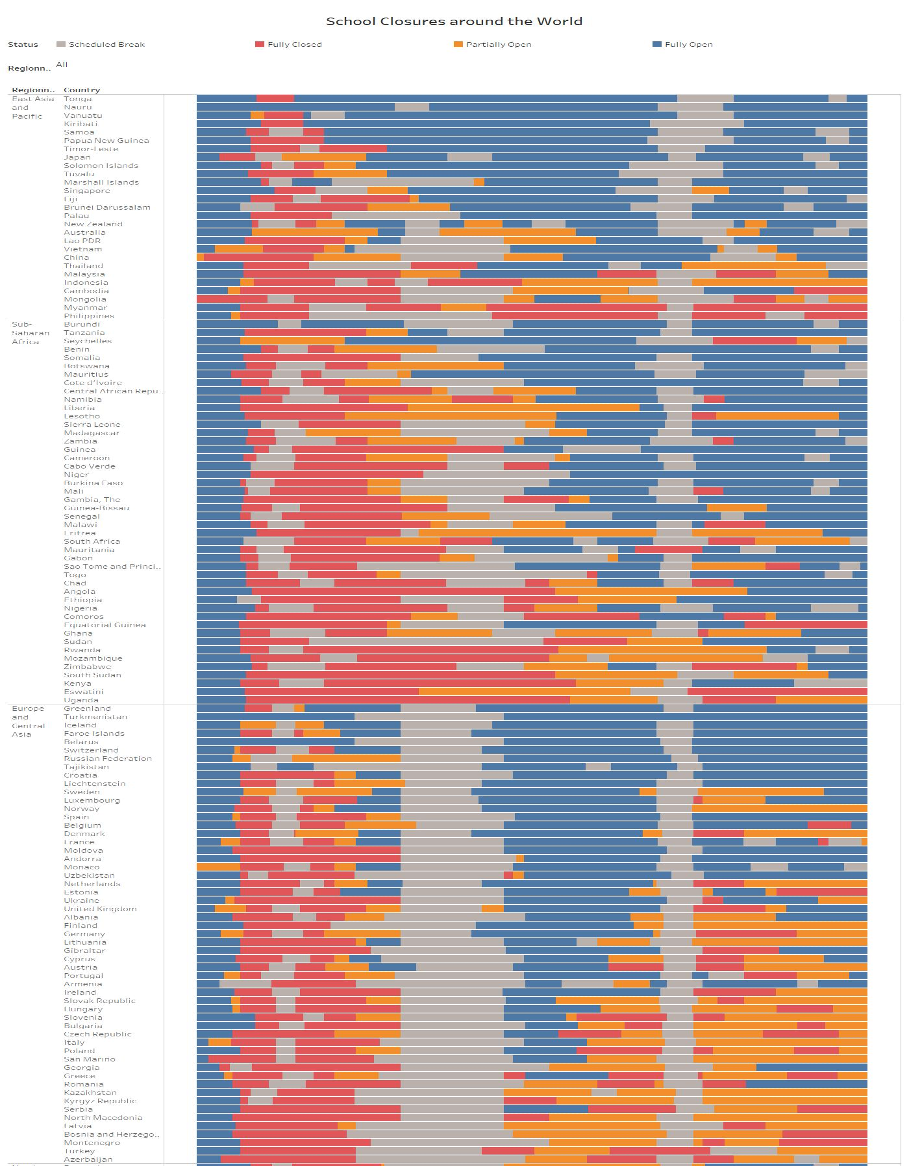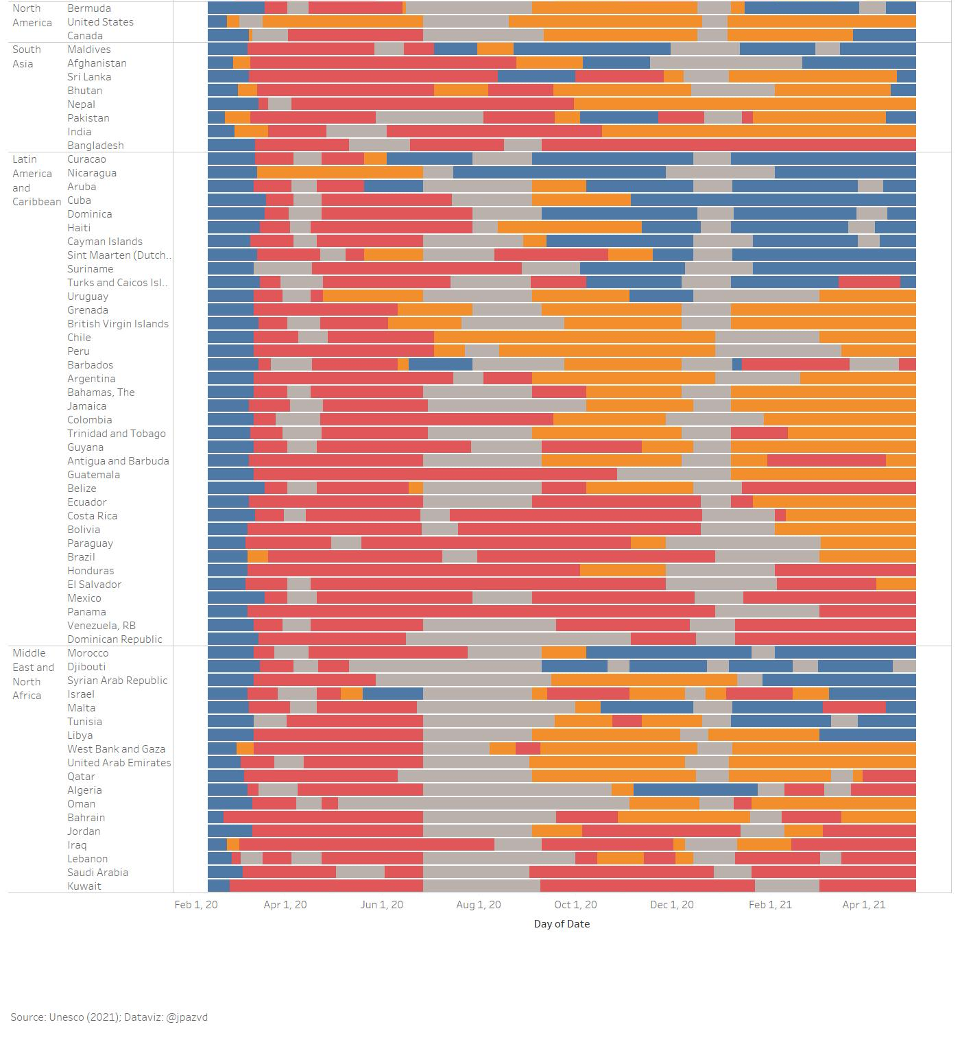Education Systems' Response to COVID-19 - Brief June 7th, 2021: Getting Back to Learning
The COVID-19 Global Education Recovery Tracker, sourced by teams across the World Bank, Johns Hopkins, and UNICEF, monitors recovery planning efforts in more than 200 countries and territories. Based on its data, learning modalities across regions shifted in recent weeks with many more countries shifting to hybrid and returning to in-person education.

Source: World Bank, Johns Hopkins University & UNICEF (2021). COVID-19 Global Education Recovery Tracker Last updated as of 9 May 2021. Baltimore, Washington DC, New York: JHU, World Bank, UNICEF.
Getting Back to Learning - Key Policy Actions Towards Reopening
As we enter the second year of the pandemic, 168 million students have already been out of school for an entire year, and about 214 million have missed more than three-quarters of the school year of their in-person learning. Tracking of school closures is more important than ever as evidenced by the variation and trends in school reopenings and closing (see Annex)
New POLICY ACTION NOTES present key actions to help countries reopen schools and get students back to learning. The Bank’s Education Global Practice has developed a package of short Policy Action Notes that have carefully curated evidence and examples around essential policy actions and outline options for activities related to protecting health and safety in schools, modifying pedagogy to stem learning loss, and improving management to ensure implementation of these policy actions.
Health and Safety
- When is it safe to reopen schools? This note describes the parameters countries should monitor to make an evidence-based decision regarding reopening schools.
- How can we minimize disease transmission in schools? This note provides evidence on mitigation strategies that can help reduce transmission within schools.
Modifying Pedagogy
- What are the options for restructuring the academic calendar to address learning loss and support student well-being? This note describes ways to generate more instructional time to regain lost learning and offers advice on how to prepare for future shutdowns.
- How can the curriculum be adapted to address student and teacher needs? This note examines how countries can prioritize core subjects and incorporate social-emotional learning into the curriculum, and also help teachers by providing modified detailed lesson plans.
- Which strategies encourage re-enrollment of vulnerable students? Many countries will find it challenging to ensure that all students, especially girls, refugees, and other vulnerable populations, return to school. This note presents approaches that countries can adopt to encourage re-enrollment of these groups.
- How can countries prepare and support teachers? The pandemic has substantially increased demands on teachers and has increased the complexity of their jobs. This note offers guidance on how countries can re-engage teachers and improve their well-being to enhance their effectiveness post-pandemic.
- What can countries do to support learning at home? Remote instruction has taken many forms. This note describes how learning at home strategies can continue after schools reopen to mitigate learning losses, as well as how to identify students who may have been exposed to abuse and neglect during school closures.
- How should countries approach learning assessments and exams? This note discusses how learning assessments can help teachers, schools, and education systems identify learning needs to reduce learning losses. To ensure safety and give every child equal opportunity, education systems can also modify or eliminate high-stakes examinations.
- What remedial education options are available? This note describes how teaching students at their own level can help them stem learning losses and catch up to grade-level standards, as well as other strategies that have been found to improve student learning in various contexts.
Management
- How can countries prepare and support school leaders? School administrators have taken on substantial additional responsibilities during the pandemic. This note identifies ways countries can empower and assist school leaders during reopening process.
- What strategies help communication with stakeholders? Communication has been a key element of effective COVID-19 response. This note summarizes good practice on how, when, and what to communicate to different stakeholders.
With schools’ re-openings students will need tailored and sustained support to help them readjust and catch-up after the pandemic. The COVID-19 Global Education Recovery Tracker (covideducationrecovery.global) showcases information on status of schooling, modalities of learning, availability of remedial educational support, and status of vaccine availability for teachers. As of the end of May, a graphs section has been added to illustrate in-person educational supports, as well as remote educational supports available at pre-primary, primary, lower, and upper secondary levels.

From left: In-person educational support for pre-primary; remote educational support for primary level. Updated as of May 9, 2021.
The joint WB-JHU-UNICEF team has also recently published a blog, which is the first of a series highlighting key data from the tracker:
- 45% of countries have moved towards hybrid education as the new normal.
- Only 43% of countries that have the vaccine are vaccinating teachers or school staff.
- Over 50% of countries are using multiple strategies to combat learning loss and provide additional support.
(Other) Research and Latest Findings
A new report by the World Bank’s Europe and Central Asia Education team "Learning Recovery after COVID-19 in Europe and Central Asia: Policy and Practice" focuses on specific and timely recommendations to address learning losses. The note presents in depth design and implementation details for a learning recovery plan, which includes three stages: (i) Coping with the closing of schools through remote learning, instructional and psychosocial support, and compensatory programs for preventing learning losses; (ii) Managing Continuity where reopened schools focus on providing foundational skills in language, math, and science to reduce learning loss and to improve learning among minorities and the poor; and (iii) Improving and Accelerating learning, by making schools more resilient and equitable through educational innovations that include the lessons learned from remote instruction during the pandemic, and where the entire system is evaluated for results.
A World Bank report estimates the long-term impacts of schooling disruptions on private returns to schooling in Kuwait. It applies an instrumental variables approach to estimate the private returns to schooling, using unique civil service payroll data, with Kuwaiti students’ exposure to the Gulf War (1990–91) as the instrument. While the results are of interest on their own, they can also prove to be useful in the context of recent efforts to assess the costs of disrupted schooling during the COVID-19 pandemic.
Some initial studies show important learning losses in developed countries, this study conducts a thorough analysis of recorded learning loss evidence documented between March 2020 and March 2021.
The latest Asian Development Outlook 2021 report highlights the impact of school closures in Asia. Learning losses range from 8% of a learning-adjusted year of schooling in the Pacific, where schools have mostly stayed open, to 55% in South Asia, where school closures have been longest. Learning losses will reduce the future productivity and lifetime earnings of affected students. The present value of these losses is estimated at $1.25 trillion for developing Asia, equivalent to 5.4% of the region’s 2020 gross domestic product (GDP).
School closures have been a common tool in the battle against COVID-19. Yet, their costs and benefits remain insufficiently known. This study uses a natural experiment that occurred as national examinations in The Netherlands took place before and after lockdown to evaluate the impact of school closures on students’ learning. The Netherlands is a “best-case” scenario, with a short lockdown, equitable school funding, and world-leading rates of broadband access. Despite these favorable conditions students made little or no progress while learning from home. Learning loss was most pronounced among students from disadvantaged homes.
Governments should act swiftly to redress the harm caused to children’s education in the wake of the unprecedented disruption from the Covid-19 pandemic, Human Rights Watch said in a report accompanied by an interactive feature, exploring common barriers to education exacerbated during the pandemic.
COVID-19 has changed the way we understand school building ventilation and its importance in keeping us safe from viruses and bacteria in the air. The pandemic has motivated many school leaders to invest in improvements to ventilation systems, but the benefits of investing in a safe learning environment extend far beyond protecting children from the coronavirus. The evidence presented in this paper suggests that pollution exposure is not only a factor in student academic outcomes, but also a major driver of inequality.
World Bank Blogs, Events, and Other Resources
World Bank Blogs
- Getting back to learning: key policy actions for reopening schools (English)
- Mapping the road to recovery: How a new venture helps track learning in the wake of the pandemic (English)
- What is hybrid learning? How can countries get it right? (English/ Spanish/ French)
- How can countries implement low tech remote learning? Using the experiences from Edu Radio and Edu TV in Sierra Leone and Pakistan to develop Knowledge Packs (English)
- Regional priorities for skills and technical education in the Eastern Caribbean States amid COVID-19 (English)
- Assessing outside of the “classroom box” while schools are closed: The potential of phone-based formative assessments to support learning continuity (English)
- Teacher pay in performance; Does it really work? (English)
- Will every child be able to read by 2030? (English)
- The path to Angola’s bright future starts with empowering girls (English)
- Online learning; the trojan horse of education (English)
- Learning after COVID-19: An education proposal (English)
- Like a phoenix: Sierra Leone’s journey to build back better after crisis strikes (English)
- Combatting the impact of COVID-19 school closures in Bangladesh (English)
- COVID-19: Bringing girls back to school (English)
- Innovative methods to monitor development programs during COVID-19: An application in Zambia (English)
- The costs of growing up during the pandemic (English)
ANNEX: School closures days per country

